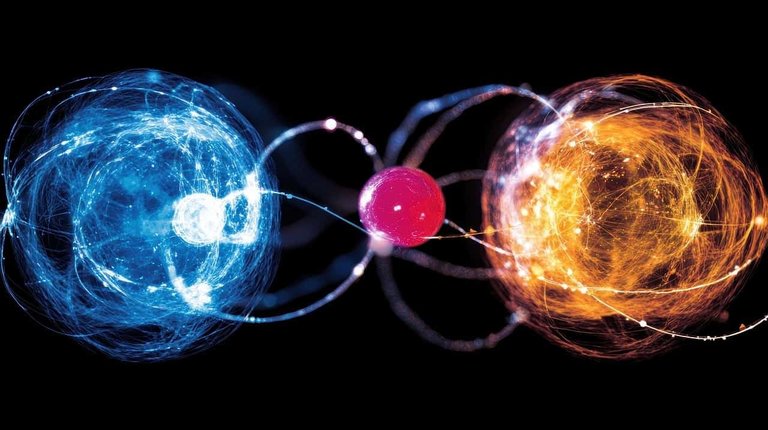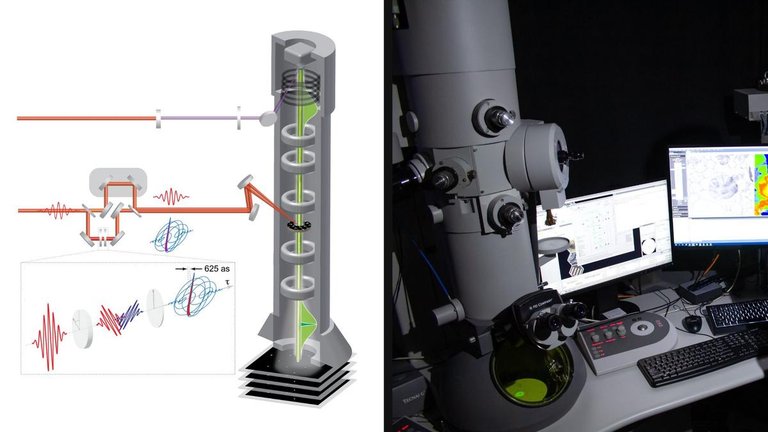Source

Last year's Nobel Prize in Physics was awarded to Pierre Agostini of Ohio State University, Ferenc Krausz of the Max Planck Institute for Quantum Optics and the University of Munich, Germany, and Anne L'Huillier of Lund University, Sweden, for their pioneering contributions to the development of experimental methods that generate extremely short (attosecond) pulses of light.
En la convocatoria del Nobel del año pasado, el premio de física lo recibieron los científicos Pierre Agostini, de la Universidad Estatal de Ohio (EEUU), Ferenc Krausz, del Instituto Max Planck de Óptica Cuántica y la Universidad de Múnich (Alemania) y Anne L'Huillier, de la Universidad de Lund (Suecia) por sus contribuciones pioneras en el desarrollo de métodos experimentales que generan pulsos de luz extremadamente cortos (attosegundos).
To put this into context, an attosecond is one quintillionth of a second (10E-18). Based on this knowledge, another group of scientists has created an electron microscope that allows us to "photograph" ultra-fast processes that allow us to observe the movements of electrons inside atoms and molecules.
Para ponernos en contexto, un attosegundo es la trillonésima parte de un segundo (10E-18). Basados en estos conocimientos otro grupo de científicos ha creado un microscopio electrónico con el que podemos "fotografiar" procesos ultrarrápidos que permiten observar los movimientos de los electrones dentro de átomos y moléculas.

Source
Unlike traditional microscopes that use visible light, electron microscopes use electron beams and ultra-short pulses of light that, when interacting with the sample, allow the movement of electrons to be visualized in a way never seen before, and this advance opens up endless possibilities in various fields.
A diferencia de los microscopios tradicionales que utilizan luz visible, los microscopios electrónicos emplean haces de electrones y pulsos de luz ultra cortos que, al interactuar con la muestra, permiten visualizar el movimiento de los electrones de una manera nunca antes vista y este avance abre un sinfín de posibilidades en diversos campos.
In the field of physics, it will allow us to study quantum phenomena in greater detail and better understand the nature of matter; in chemistry, it will help to analyse chemical reactions at a molecular level and design new materials with specific properties and in biology, it will facilitate research into biological processes at a nanometric scale, such as photosynthesis or the functioning of enzymes.
En el campo de la física permitirá estudiar con mayor detalle fenómenos cuánticos y comprender mejor la naturaleza de la materia, en química ayudará a analizar reacciones químicas a nivel molecular y diseñar nuevos materiales con propiedades específicas y en biología facilitará la investigación de procesos biológicos a escala nanométrica, como la fotosíntesis o el funcionamiento de las enzimas.
Source

To obtain these extremely short pulses, a high-power laser is used that produces very intense but relatively long pulses of light. These pulses are amplified to increase their energy and are directed at a noble gas (such as xenon or argon). The interaction between the intense light and the gas generates a series of high-frequency harmonics from which an extremely short pulse of light is obtained.
Para obtener estos pulsos tan extremadamente cortos se utiliza un láser de alta potencia que produce pulsos de luz muy intensos pero relativamente largos, estos pulsos se amplifican para aumentar su energía y se dirigen a un gas noble (como el xenón o el argón). La interacción entre la luz intensa y el gas genera una serie de armónicos de alta frecuencia de los que se obtiene un pulso de luz extremadamente corto.
In short, this type of microscope, which has been called "the world's fastest microscope", is an invaluable tool for scientific research that brings us ever closer to unraveling the mysteries of nature at the atomic and molecular level, which will lead to increasingly sophisticated technologies and, as Arthur C. Clark would say, more indistinguishable from magic.
En resumen, este tipo de microscopio, al que se le ha denominado "microscopio más rápido del mundo", es una herramienta invaluable para la investigación científica que nos acerca cada vez más a desentrañar los misterios de la naturaleza a nivel atómico y molecular, lo que derivará en tecnologías cada vez más sofisticadas y, como diría Arthur C. Clarck, más indistinguibles de la magia.
More information/Más información
https://interestingengineering.com/science/worlds-fastest-microscope-captures-electron-motion
The world of science is really moving at a very fast pace and this is really moving at a very fast pace